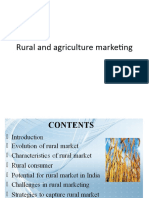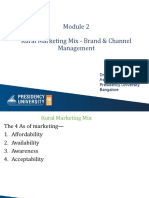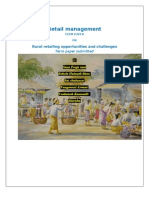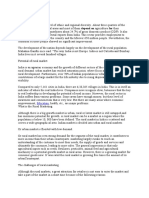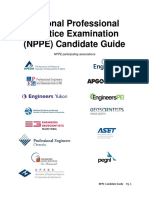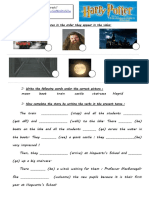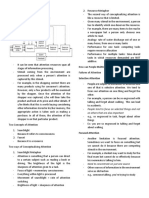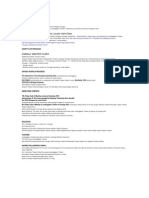MARKET APPLICATION PRACTICES
RURAL MARKETING
Presented by: Ankita Agarwal Sejal Bhodia Sonam Ladha Priya More Priya Shah Jyoti Sharma Pooja Singh Chhavi Sonkar Trupti waychal 64 68 85 89 104 105 110 116 121
EXECUTIVE SUMMARY
1
Shraddha Sancheti 100
�Rural Market An Overview The Indian rural market has a huge demand base and offers great opportunities to marketers. Two-thirds of Indian consumers live in rural areas and almost half of the national income is generated here. The reasons for heading into the rural areas are fairly clear. The urban consumer durable market for products like colour TVs, washing machines, refrigerators and air conditioners is growing annually at between 7 per cent and 10 per cent. The rural market is zooming ahead at around 25 per cent annually. "The rural market is growing faster than urban India now," says Venugopal Dhoot, chairman of the Rs 989 crore (Rs billion) Videocon Appliances. "The urban market is a replacement and up gradation market today," adds Samsung's director, marketing, Ravinder Zutshi. Objective 'Go rural' is the slogan of marketing gurus after analyzing the socioeconomic changes in villages. The Rural population is nearly three times the urban, so that Rural consumers have become the prime target market for consumer durable and non-durable products, food, construction, electrical, electronics, automobiles, banks, insurance companies and other sectors besides hundred per cent of agri-input products such as seeds, fertilizers, pesticides and farm machinery. The Indian rural market today accounts for only about Rs 8 billion of the
2
�total ad pie of Rs 120 billion, thus claiming 6.6 per cent of the total share. So clearly there seems to be a long way ahead.
Challenges in Rural Marketing Though rural markets are a huge attraction to marketers, it is not easy to enter the market and take a sizeable share of the market, in the short time due to the following reasons.
1. Low Literacy:
There are not enough opportunities for education in rural areas. The literacy level is as low (36%) when compared to all- India average of 52%.
2. Seasonal Demand:
Demand for goods in rural markets depends upon agricultural situation, as agriculture is the main source of income. Agriculture to a large extent depends upon monsoon and, therefore, the demand or buying capacity is not stable or regular.
3. Transportation:
Many rural areas are not connected by rail transport. Kacha roads become unserviceable during the monsoon and interior villages get isolated.
4. Distribution: 3
�An effective distribution system requires village-level shopkeeper, Mandal/ Taluka- level wholesaler or preferred dealer, distributor or stockiest at district level and company-owned depot or consignment distribution at state level. The presence of too many tiers in the distribution system increases the cost of distribution.
5. Communication Problems:
Facilities such as telephone, fax and telegram are rather poor in rural areas.
6. Traditional Life:
Life in rural areas is still governed by customs and traditions and people do not easily adapt new practices. For example, even rich and educated class of farmers does not wear jeans or branded shoes.
7. Buying Decisions:
Rural consumers are cautious in buying and decisions are slow and delayed. They like to give a trial and only after being personally satisfied, do they buy the product.
8. Media for Promotions:
Television has made a great impact and large audience has been exposed to this medium. Radio reaches large population in rural areas at a relatively low cost. However, reach of formal media is low in rural households; therefore, the market has to undertake specific sales promotion activities in rural areas like participating in melas or fairs.
4
�9. Career in Rural Market:
While rural marketing offers a challenging career, a rural sales person should require certain qualifications and specialized talent.
10. Cultural Factors:
Culture is a system of shared values, beliefs and perceptions that influence the behavior of consumers. There are different groups based on religion, caste, occupation, income, age, education and politics and each group exerts influence on the behavior of people in villages. There is a belief among rural people that experience is more important than formal education and they respect salespersons who can offer practical solutions to their problems. Therefore, it is desirable that sales persons, especially those who have been brought up in cities are given a thorough training consisting of both theory and practical aspects of village life. The training will help these sales persons to align themselves with the market realities and settle down smoothly in their jobs. Rural market has a tremendous potential that is yet to be tapped. A small increase in rural income, results in an exponential increase in buying power.
Future Trends
�Markets which are not able to face the stiff competition posed by MNCs, can restore their profits in the rural sector. The market share of urban market when compared to the rural market is low, hence if Indian industries concentrate on rural markets their sales will increase. If rural markets are brought into the limelight of development, they pave way to prosperity. Prosperity of India lies in the prosperity of every Indian, hence no rural segment should be left untapped.
THEOROTICAL ASPECT OF OUR PRODUCT
�Product Category: Automobile (4 Wheeler) Product Name: MarutiDreamz Product features:
Fuel Economy Mileage Highway (km/liter) Mileage City (km/liter) Mileage Overall (km/liter) Capacities Seating Capacity (person) Fuel Tank Capacity (liter) 5 25 18.3 14.6 17.0
Performance Maximum Speed 0-100kmph Transmission Transmission Type Gears/Speeds Manual 5Gears 120Km/Hour 23.5seconds
Steering Steering Type Power Assisted Standard
Brakes Front Brakes Rear Brakes Wheels and Tyres Disc brakes Drum
�Wheel Type Wheel Size Tyres 12" 145 / 80 R12
Suspensions Front Suspension Rear Suspension Independent, Lower Wishbone, McPherson Strut with gas filled dampers Independent, Semi Trailing arm with coil spring & gas filled shock absorbers
WITH CHILD SAFETY LOCKS WHICH IS NOT THERE IS NANO
Tagline: Rural: Ek Kadam Aage Urban: A Step Ahead Positioning in Rural market: Aapne Socha, Humne Banaya Positioning in Urban Market: Live Life King Size
�ANALYSIS & INTERPRETATION
9
�(Question, Graph and Interpretation of that graph..) 1) What is monthly income?
Interpretation According to our survey we observed that 30 people, 12 people & 10 people out of 52 people of Dahiwali village fall in the income bracket of 10,000 15,000, above 15,000 & 5000 10,000 respectively per month.
2) What is the mode of transport people generally use?
Interpretation We found out that 77% of the population in the Dahiwali village prefers other modes of transport like bus, train, &auto for travelling. Only 8% of them prefer to travel by four wheeler and 33% prefer to travel by two wheeler.
10
�3) Which Brand in Four wheelers?
Interpretation We also found that only 2 families out of 52 families own a Santro & a Safari, a Wagon R & a Swift is owned by 3 families out of the 52 families respectively.
4) How many of them are ready to take the car if given them the loan facility?
Interpretation We found out that if given a loan facility to 40 people of Dahiwali village they are willing to buy the car & 12 people in spite of the loan facility would not prefer buying the car.
5) What is the budget to buy a car?
Interpretation
11
�We found out that if 35 people of Dahiwali village are offered a car ranging less than RS.2,00,000/- then they would buy the car & 5 people of them are willing to buy the car even if it is more than RS.2,00,000/6) What all requirements/ accessories are expected while purchasing a car?
Interpretation We found out that 17 people out of 52 have basic requirement of A/C while purchasing the car & 5 people are looking out for driving classes facility & remaining 30 are looking for other accessories like the music system, seat cover & carrier while purchasing the car.
12
�OBSERVATIONS & FINDINGS
Our findings of Dahiwali village are as follows: 1) The local people prefer using the public transport for their daily short distance activities 2) The majority of the peoples monthly income is in the bracket of 10,000 to 15,000 which does not fall in the category of high income 3) Since the majority population belongs to the low income group they lack monetary resources to purchase a car 4) According to our survey most of the people will prefer buying a car if they are provided with financial assistance in terms of loans
13
�5) Though for short distances people prefer using public transports like rickshaws, buses, trains etc, but for long distances and particularly family outings people definitely prefer their own vehicle 6) Most of the families had two wheelers and also if given a choice between a car and a bike they would prefer purchasing a bike because its more fuel efficient and more suitable for day to day and daily activities
MARKETING PLAN Marketing strategy for rural market: Local cable advertisement: We will give promotional ads on the local cable channel of Dahiwali wherein the ad will depict the features of our car and also the benefits to the consumers will be highlighted in it. MERI GADDI advertisement: In this we will click the photographs of our buyers and display it in the advertisement on the local cable. So the people of their village will see the ads and get provoked to buy car. PANCHAYAT HEADS will be given a free ride:
14
�The Panchayat head, the opinion leaders and the influential people of the village will be given free rides all across the villages during the launch period. Launch during GANPATI festival: we will launch our car during ganpati festival around mid week of September , which will help us to touch the emotional side of our target market. Also, ads will be shown wherein god Ganpati will be driving our car. We will use flighting strategy for telecasting our ads in this period. Lucky draw contest: These lucky draw contest will be held in the first 3 months from our launch wherein the lucky one will be getting a free trip of 2 nights and 3 days to mahabaleshwar. Prizes and gifts: The customers of first 10 bookings for our car will be given free water purifiers. N2N: Car maintenance is a time-consuming process, especially if you own a fleet. Marutis N2N Fleet Management Solutions for companies, takes care of the A-Z of automobile problems. Services include end-to-end backups/solutions across the
15
�vehicles life: Leasing, Maintenance, Convenience services and Remarketing.
Maruti Driving School (MDS): Maruti has established this with the goal to capture the market where there is inhibition in buying cars due to inability to drive the car. This brings that customer to Maruti showroom and Maruti ends up creating a customer.
4 M PLANNING
Men The company has a multi-tier management structure, comprising:
16
�1. Board of Directors 2. Managing Executive Officers 3. Executive Officers 4. Divisional Heads Through this it is ensured that: 1. Strategic supervision is provided by the board. 2. Control and Implementation of Companys strategies is achieved effectively. 3. Operational management remains focused on implementation. Information regarding the companys operations and financial performance are made available adequately. Delegation of decision making with accountability is achieved. Financial and operational control and integrity are maintained at operational level. Risk is suitably evaluated and dealt with. The employees of Maruti, from technicians to engineers to sales persons, have fully imbibed the Japanese work culture of making
17
�constant improvement, and placing the prosperity of the company as the means of their own advancement MONEY For its Indian operations, the company plans to invest Rs 9,000 Crore by 2010. The company has also made huge investment in the plant situated at Manesar, that is almost ready to reach its peak production level of 300,000 units. The company also operates at the new engine facility located at Gurgaon. Maruti Suzuki has a good network of internal resources to finance the companys operations, expansion plans as well as capital investments. MACHINERY The Manesar plant of the company established in 2006achieved an expanded installed capacity of 1,70,000 units at the end of first year. The models of Swift, SX4 and Dzire are manufactured in Manesar.
18
Recently, the company has introduced a peppy k series engine for its new car, Maruti Suzuki A-star.
In future, it aims to produce more environment-friendly car engines.
The company plans to design cars that are fuel efficient and lower on CO2 emissions. It also has plans to develop hybrid, electrical, and multi-fuel engines
MATERIALS Maruti uses the following materials to reduce its energy consumption while manufacturing cars: Energy efficient fans in cooling towers Special transformers to minimize the energy losses. Energy efficient motors and blowers in the air washer system for shop cooling Energy efficient chillers for air conditioning. Building Management System and Variable Air Volume System for optimized cooling in the work places and reduce the energy consumption.
19
� Increased re-use of waste heat of combustion for running equipment. Energy efficient lighting. Energy efficient air driers.
METHODOLOGY Small is Beautiful Maruti Suzuki has a firm belief that the future of Indian car industry belongs to small cars. The rising fuel prices, high input costs and congested city roads is paving way for small, light-weight and fuel efficient cars. Even the government is supporting the introduction of small cars with favorable policies. Exuding companys confidence on growth of small cars, Maruti Suzuki aims to roll out more numbers of small cars for the Indian sub-continent. Re-enter Europe Maruti Suzuki re-entered European market with a global car that is fuel-efficient and lower on CO2 emissions.
20
This new car christened as Maruti Suzuki A-Star was launched in Europe with the brand Suzuki Alto.
Maruti has announced to launch another world strategic car model, Maruti Suzuki Splash.
BIBLIOGRAPHY
http://content.authorstream.com/pptp244895633895398103287 50.pptx
http://www.optimum7.com/internet-marketing/business-strategy/newmarketing-focus-general-motors.html http://www.aboutpublishinggroup.com/samples/marketing_sample.pdf
21
